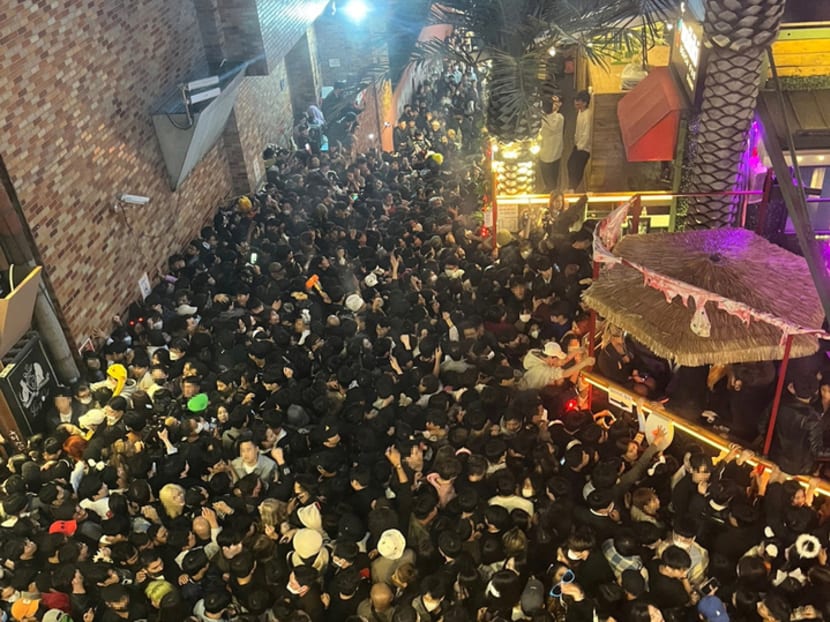Explainer: Seoul's crowd crush tragedy — what to do in such a situation and how it's different from a stampede
SINGAPORE — As the shocking reality of what unfolded in Seoul last Saturday night (Oct 29) became clear, many media reports initially said the tragedy had resulted from a "stampede". Experts have told TODAY that this is the wrong term for what was, in fact, a crowd crush.

A scene showing part of the crowd trapped in a narrow alleyway in Seoul's Itaewon district on Oct 29, 2022.
- The Halloween tragedy in Seoul is correctly described as a "crowd crush" and it is wrong to call it a "stampede", experts said
- The distinction must be made as it can affect crowd control measures, they said
- Injuries one may sustain in a stampede may vary but the outcomes are largely similar to a crowd crush
- In both scenarios, deaths are also usually caused by suffocation, when the pressure created by people piling up can obstruct breathing
- In past incidents, very thick metal railings were bent from the pressure of the crowd, which shows how much force can be exerted when a crowd moves
SINGAPORE — As the shocking reality of what unfolded in Seoul last Saturday night (Oct 29) became clear, many media reports initially said that the tragedy had resulted from a "stampede". Experts have told TODAY that this is the wrong term for what was, in fact, a crowd crush.
The experts said that the causes and characteristics of these two types of out-of-control crowd events are quite different, though superficially, they may appear to be similar.
At least 150 people, mainly teenagers, died and more than 80 people were injured when celebrating Halloween in the Itaewon nightlife district of the South Korean capital.
An estimated 100,000 people thronged a narrow alley for their first Halloween celebrations after distancing restrictions for Covid-19 in the country were lifted. Social media footage of the incident showed people scrambling to get out of the crowd in the downhill alley as people piled up on top of one another.
On Tuesday, national police chief Yoon Hee-keun admitted that the police had received "multiple reports" urgently indicating danger in the area, but handled the information in an "insufficient" way.
This came after widespread public anger over the lack of crowd management measures from law enforcement agencies.
TODAY looks at the differences between a stampede and a crowd crush and what to do if you are caught in such situations.
STAMPEDE VS CROWD CRUSH: WHAT IS THE DIFFERENCE?
Associate Professor Razwana Begum from the Singapore University of Social Sciences (SUSS) said that a stampede occurs when a group of people are running away from danger, often in the same direction, or they are running towards something exciting.
For instance, when everyone is running out of an auditorium towards the exit to escape a fire or, when they are surging enthusiastically towards an artiste on stage at a concert.
The second was the case at American rapper Travis Scott’s much-anticipated Astroworld Festival last November, where 10 people died during a performance.
Assoc Prof Razwana said that the terms "crowd crush", "crowd surge" and "crowd collapse" are used when a large crowd is in a confined space, unable to move freely and there is no exit or room to move out of the venue.
“In such a situation, people get restless, it is hot, and some may find it hard to breathe. They end up pushing to get away from the space and this is when a crowd crush occurs,” she said.
This was the case in Indonesia last month, where at least 130 people died after the police fired tear gas in a stadium where half of the doors were locked, causing a crush at the exits.
Experts said that injuries one may sustain in a stampede may vary but the outcomes are largely similar to a crowd crush. In both scenarios, deaths are also usually caused by suffocation.
Associate Professor Claudio Feliciani from the Research Center for Advanced Science and Technology in the University of Tokyo said that the pressure created by the people piling up in such incidents can obstruct their breathing.
In past accidents, very thick metal railings were bent from the pressure of the crowd, which shows how much force can be accumulated when people move in a crowd.
WHY IS IT VITAL FOR ORGANISERS OF MASS CROWD EVENTS TO LIAISE WITH THE AUTHORITIES?
Assoc Prof Feliciani, who co-authored the book Introduction to Crowd Management, said: “In crowd management, the communication between all the parts involved is imperative.''
He added that organisers of events with large crowds need to coordinate with the authorities, police, transportation companies, firefighters and others.
"It should be clear to everyone which situation is to be considered safe or dangerous and how to report that.”
Associate Professor Ishani Mukherjee at the Singapore Management University whose research is in public policy said that with a pent-up demand for gatherings and events after two years of distancing and restrictions during the pandemic, people may want to celebrate festivities to the fullest, something she herself has felt.
Yet, the safety of people taking part in these activities should be a priority for both law enforcement agencies and the public in public spaces.
“Good urban planning is imperative to crowd management. And this goes hand in hand with the work of law enforcement agencies who must effectively coordinate regarding the safety of large public events to avoid dangerous situations,” Assoc Prof Mukherjee said.
WHAT DO YOU DO IF YOU FIND YOURSELF IN A CROWD CRUSH?
Experts said there are several things that people can do to keep themselves safe in such situations.
They include:
- Making space around your chest
- Staying away from the ground
- Following the flow of the crowd
- Avoiding solid objects such as walls, barriers and fences
- Keeping calm and looking for exit signs
- If on the ground, stay in a foetal position and try to get up quickly
Dr Omer Ali Saifudeen, a senior lecturer of the Public Safety and Security Programme at SUSS, said: “A typical rule of thumb is to leave the area when you realise you are losing your autonomy in movement in the direction you want to go and are instead being pushed along with a crowd.
"If there is a shop or cafe to take refuge in momentarily, do so. Anything to get away from the surge.”
However, there are, of course, times when it is difficult to be aware of how big the crowd has become, Assoc Prof Mukherjee said.
“Sometimes, this happens in concerts. You’re in with the spirit of the crowd and there’s a rave, you lose the awareness of how crowded it is for yourself. So in high-crowd situations, being doubly aware of your surroundings is important.”
It is also good to check the crowd density at every venue, the experts said.
Prof Feliciani said that when there are three to four people in every square metre (sqm), stop-and-go waves are observed. This means that people need to stop continuously since they cannot walk smoothly, such as in a traffic jam.
This should trigger an alarm, he cautioned.
“Packed trains in the morning rush can reach about six people per sqm but people don’t move and there are a lot of personnel checking for safety, so that’s different because it’s a more controlled environment.”
Assoc Prof Razwana said that having more than six people per sqm is not advisable and potentially dangerous.








